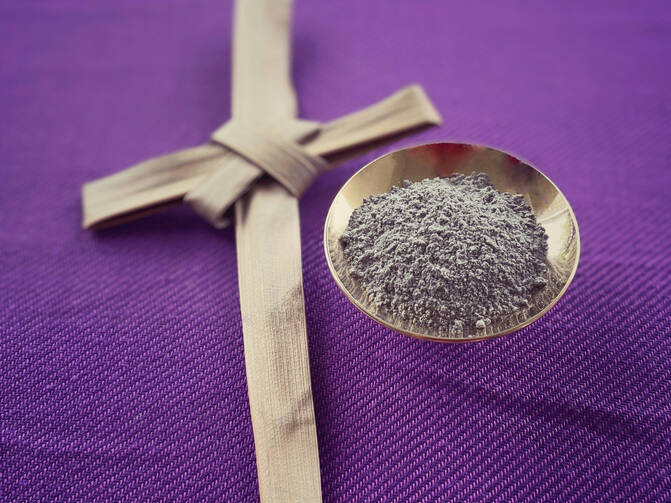“Keep in mind that you are made of dust and will return to dust.”
I reached up on my tiptoes, extending my arms from my shoulders to my fingertips to touch the forehead of my student. With my right thumb, I gently traced a cross just above the space between his eyebrows, moving up and down, then left and right. Despite his towering height, a full foot above my 5’3” frame, he bent slightly to meet me at eye level.
The act of distributing ashes on Ash Wednesday as part of my work in college campus ministry provides a unique closeness with my students. While I engage with them in various ways—through conversations, events, and daily encounters on campus—there is a profound depth to our interaction on this particular day. It is a moment of prescribed ritual that resonates deeply with me at the beginning of each Lenten season. Acknowledging the mortality of young adults feels like holding up a mirror to the fleeting nature of life. Many of my students are in the prime of their youth, investing their college years in personal growth and development, preparing for the future. They navigate through relationships and experiences that shape them during these formative years, laying the foundation for the life that awaits beyond graduation. The college experience is a journey of self-discovery and preparation for the road ahead; pausing to reflect on death disrupts our usual routines on campus.
My first experience of distributing ashes was during the pandemic in 2021 while working at Boston College. The university made efforts to provide safe opportunities for students to receive ashes on Ash Wednesday. Although Ash Wednesday is not a mandatory religious observance, the act of receiving ashes—more so as a wearable symbol than a somber reminder of mortality—attracts a large number of students and staff who may not regularly attend Mass. On this day, they join those who participate in daily or Sunday liturgies. To accommodate as many people as possible while adhering to safety guidelines, Boston College organized multiple ash distribution services across campus at various times throughout the day and evening.
The significance of assisting with ash distribution truly struck me during the evening Mass at St. Ignatius Church. Standing outside on the church steps, masked and shivering, I witnessed a long line of students extending down the steps and around the corner, waiting to receive ashes. It was a powerful sight, seeing them maintain safe distances as they approached to mark the beginning of Lent and acknowledge their mortality. I vividly remember returning home that night, running my thumb under warm water to thaw it after enduring the cold New England weather.
This poignant experience of distributing ashes amidst a backdrop of collective contemplation on mortality during the pandemic highlighted our shared vulnerability and fragility as human beings. The challenges of masking, distancing, and navigating pandemic protocols constantly reminded us of our mortality and the delicate nature of life. Yet, despite these trials, we gathered together to affirm the transient nature of our existence.
In the years following that initial ash distribution, I have continued the tradition of marking my students with ashes on Ash Wednesday. While the ritual carries a solemn tone, there are moments of lightness, especially when working with young individuals. Some students have humorously critiqued my “cross technique,” noting the varying clarity of the crosses I draw on their foreheads. Observing the congregation post-ashing, it is evident who bears a distinct cross and who sports a smudged mark. These playful observations add a touch of levity to the solemnity of the occasion.
Imposing ashes is a profound act that blends the sacred with the mundane. It involves a gentle touch, as my thumb glides across the forehead of each individual—whether their skin is oily, dry, scarred, or adorned with makeup. This physical connection, combined with the solemn reminder of mortality, creates a moment of deep reflection amidst the busyness of life. Looking into someone’s eyes and affirming the eventual return to dust is a solemn yet sacred gesture that resonates with truth.
As I prepare for this upcoming Lent, I am filled with a renewed awareness of mortality, intertwined with the anticipation of welcoming my son into the world later this year. Despite not yet feeling his movements within me, the physical changes of pregnancy remind me of the life growing inside. The juxtaposition of nurturing new life while contemplating mortality underscores the cyclical nature of existence. Ash Wednesday serves as a poignant reminder that both my son and I are destined to return to dust, emphasizing the transient nature of life.
The practice of memento mori, meaning “Remember your death,” invites us to confront our mortality and embrace a deeper appreciation for life. This awareness, though initially unsettling, ultimately leads to a more profound and meaningful existence. The acknowledgment of death during Lent parallels Jesus’ desert experience, prompting us to confront our own struggles and sanctify ourselves in preparation for the joy of Easter.
In the midst of uncertainties and challenges, may this Ash Wednesday inspire us to embrace our shared mortality with love and compassion, fostering deeper connections with God, ourselves, and others.
